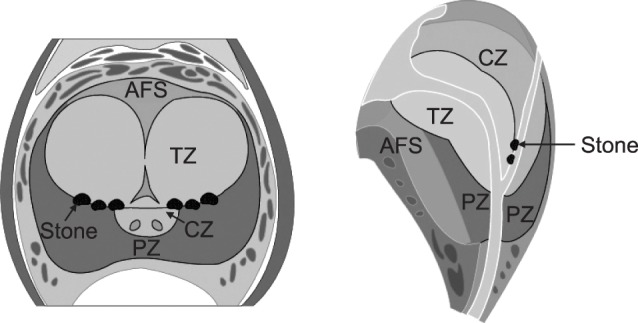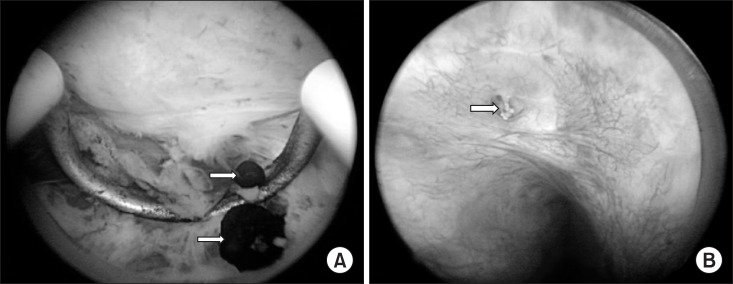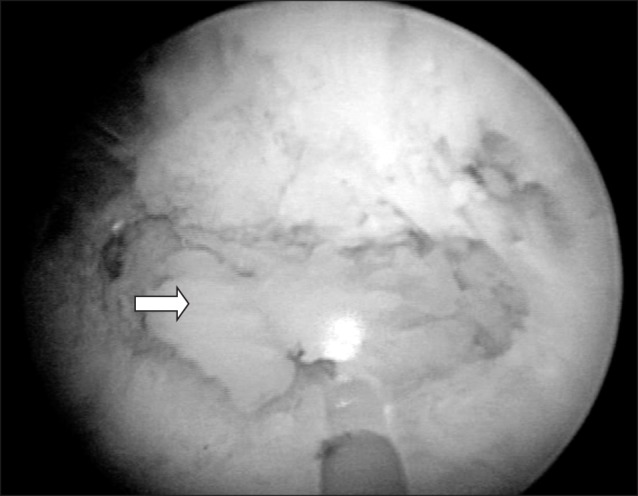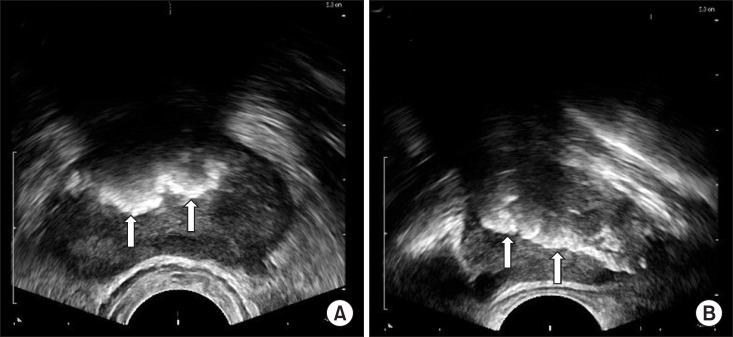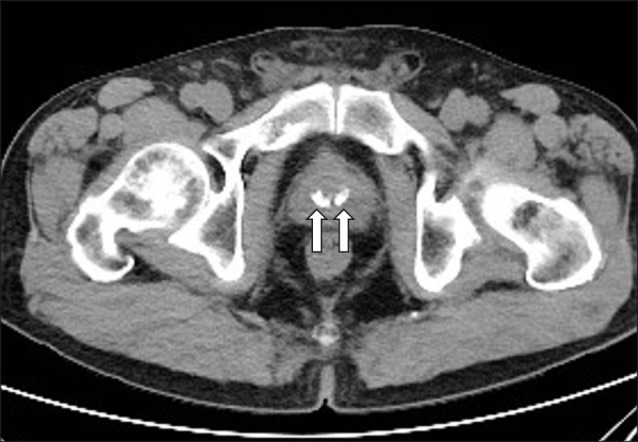World J Mens Health.
2018 Jan;36(1):15-21. 10.5534/wjmh.17018.
Clinical Significance of Prostatic Calculi: A Review
- Affiliations
-
- 1Department of Urology, Gyeongsang National University Hospital, Gyeongsang National University College of Medicine, Jinju, Korea. hyunjs@gnu.ac.kr
- KMID: 2399168
- DOI: http://doi.org/10.5534/wjmh.17018
Abstract
- Prostatic calculi often occur in middle-aged and old men. Prostatic calculi are usually classified as primary/endogenous stones or secondary/extrinsic stones. Endogenous stones are commonly caused by obstruction of the prostatic ducts around the enlarged prostate by benign prostatic hyperplasia (BPH) or by chronic inflammation. Extrinsic stones occur mainly around the urethra, because they are caused by urine reflux. The exact prevalence of prostatic calculi is not known, and it has been reported to vary widely, from 7% to 70%. Most cases of prostatic calculi are not accompanied by symptoms. Therefore, most cases are found incidentally during the diagnosis of BPH using transrectal ultrasonography (TRUS). However, prostatic calculi associated with chronic prostatitis may be accompanied by chronic pelvic pain. Rare cases have been reported in which extrinsic prostatic calculi caused by urine reflux have led to voiding difficulty due to their size. More than 80% of prostatic calculi are composed of calcium phosphate. Prostatic calculi can be easily diagnosed using TRUS or computed tomography. Treatment is often unnecessary, but if an individual experiences difficulty in urination or chronic pain, prostatic calculi can be easily removed using a transurethral electroresection loop or holmium laser.
Keyword
MeSH Terms
Figure
Reference
-
1. Klimas R, Bennett B, Gardner WA Jr. Prostatic calculi: a review. Prostate. 1985; 7:91–96. PMID: 3909127.
Article2. Lee CH, Akin-Olugbade O, Kirschenbaum A. Overview of prostate anatomy, histology, and pathology. Endocrinol Metab Clin North Am. 2011; 40:565–575. PMID: 21889721.
Article4. Young HH. Prostatic calculi. J Urol. 1934; 32:660–709.
Article5. McDonald HP, Upchurch WE, Sturdevant CE. Treatment of prostatic calculi. JAMA. 1955; 157:787–788.
Article6. Moore RA. Morphology of prostatic corpora amylacea and calculi. Arch Pathol. 1936; 22:22–40.7. Kirby RS, Lowe D, Bultitude MI, Shuttleworth KE. Intra-prostatic urinary reflux: an aetiological factor in abacterial prostatitis. Br J Urol. 1982; 54:729–731. PMID: 7150931.
Article8. Najoui M, Qarro A, Ammani A, Alami M. Giant prostatic calculi. Pan Afr Med J. 2013; 14:69. PMID: 23565316.
Article9. Sfanos KS, Wilson BA, De Marzo AM, Isaacs WB. Acute inflammatory proteins constitute the organic matrix of prostatic corpora amylacea and calculi in men with prostate cancer. Proc Natl Acad Sci U S A. 2009; 106:3443–3448. PMID: 19202053.
Article10. Dessombz A, Méria P, Bazin D, Daudon M. Prostatic stones: evidence of a specific chemistry related to infection and presence of bacterial imprints. PLoS One. 2012; 7:e51691. PMID: 23272143.
Article11. Dell'Atti L, Galosi AB, Ippolito C. Prostatic calculi detected in peripheral zone of the gland during a transrectal ultra sound biopsy can be significant predictors of prostate cancer. Arch Ital Urol Androl. 2016; 88:304–307. PMID: 28073198.12. Park B, Choo SH. The burden of prostatic calculi is more important than the presence. Asian J Androl. 2017; 19:482–485. PMID: 27184549.
Article13. Hong CG, Yoon BI, Choe HS, Ha US, Sohn DW, Cho YH. The prevalence and characteristic differences in prostatic calcification between health promotion center and urology department outpatients. Korean J Urol. 2012; 53:330–334. PMID: 22670192.
Article14. Kim WB, Doo SW, Yang WJ, Song YS. Influence of prostatic calculi on lower urinary tract symptoms in middle-aged men. Urology. 2011; 78:447–449. PMID: 21689847.
Article15. Shoskes DA, Lee CT, Murphy D, Kefer J, Wood HM. Incidence and significance of prostatic stones in men with chronic prostatitis/chronic pelvic pain syndrome. Urology. 2007; 70:235–238. PMID: 17826477.
Article16. Geramoutsos I, Gyftopoulos K, Perimenis P, Thanou V, Liagka D, Siamblis D, et al. Clinical correlation of prostatic lithiasis with chronic pelvic pain syndromes in young adults. Eur Urol. 2004; 45:333–337. PMID: 15036679.
Article17. Harada K, Igari D, Tanahashi Y. Gray scale transrectal ultransonography of the prostate. J Clin Ultrasound. 1979; 7:45–49. PMID: 108298.18. Kim SH, Jung KI, Lee BH, Lee BY, Cho SY, Kim HW. Relations between prostatic calculi and lower urinary tract symptoms of benign prostatic hyperplasia. J Korean Continence Soc. 2009; 13(1):30–36.
Article19. Lee SE, Ku JH, Park HK, Jeong CK, Kim SH. Prostatic calculi do not influence the level of serum prostate specific antigen in men without clinically detectable prostate cancer or prostatitis. J Urol. 2003; 170:745–748. PMID: 12913688.
Article20. Leader AJ, Queen DM. Prostatic calculous disease. J Urol. 1958; 80:142–146. PMID: 13564603.
Article21. Søndergaard G, Vetner M, Christensen PO. Prostatic calculi. Acta Pathol Microbiol Immunol Scand A. 1987; 95:141–145. PMID: 2440234.22. Cha WH, Kim KH, Seo YJ. The effect of periurethral prostatic calculi on lower urinary tract symptoms in benign prostatic hyperplasia. Korean J Urol. 2008; 49:237–241.
Article23. Jeon HJ, Chung HC, Song JM. Effects of residual prostatic calculi on lower urinary tract symptoms after transurethral resection of prostate. Korean J Urol. 2005; 46:569–573.24. Lee BE, Kim SK. The effects of concomitant prostatic calculi to the therapeutic results in patients with chronic bacterial prostatitis. Korean J Urol. 1989; 30:876–884.
- Full Text Links
- Actions
-
Cited
- CITED
-
- Close
- Share
- Similar articles
-
- The Effects of Concomitant Prostatic Calculi to the Therapeutic Results in Patients with Chronic Bacterial Prostatitis
- Evaluation of distribution and size of prostatic calculi in prostatism
- Large Prostatic Calculi Causing Urethral Obstruction
- 477 Bladder Calculi in a Patient with Benign Prostatic Hyperplasia
- Effects of Residual Prostatic Calculi on Lower Urinary Tract Symptoms after Transurethral Resection of Prostate

